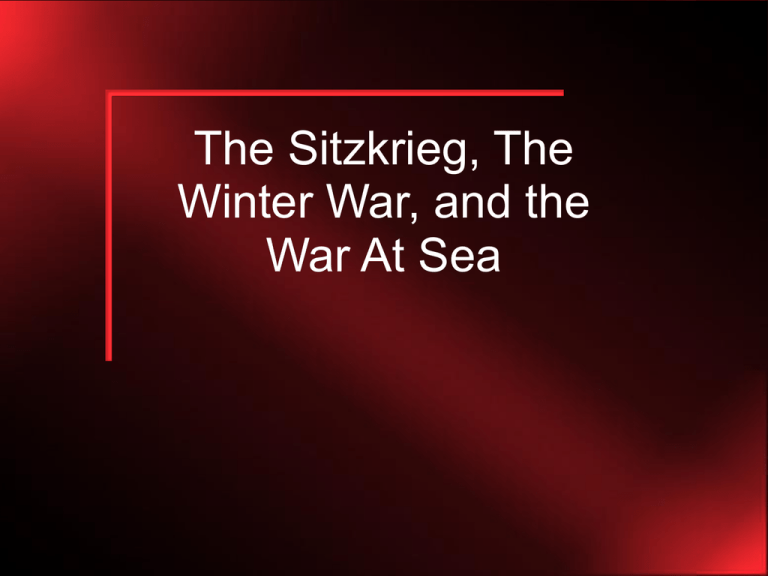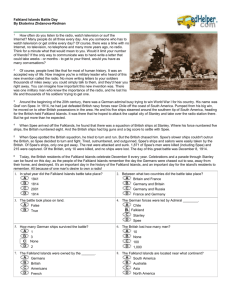The Sitzkrieg, Winter War, and War on the Sea
advertisement

The Sitzkrieg, The Winter War, and the War At Sea The Sitzkrieg • After fury of the blitzkrieg came the sitzkrieg on the Western Front – Sit down war – Also called the phony war – Was a six month lull between the fall of Poland and the German attack on Norway and Denmark The Sitzkrieg • British and French were behind the Maginot line • Germans gathered behind the Siegfried Line • Almost no combat • Ended when Germany attacks Norway and Denmark in April, 1940 Russia Invades Finland • Russia was still very active during the “phony war” • Force Estonia to give them bases on Estonian soil • Latvia and Lithuania bullied into the same thing Russia Invades Finland • Finland refused to give in to Russia • Nov. 30, 1939- Soviet army struck at Finland – Soldiers carried propaganda leaflets – Expected to be welcomed as liberators – Thought it would be quick and only had light clothing – Not equipped or trained for harsh Finnish winter The Winter War A Finnish soldier Frozen Russian soldier Russia Invades Finland • Finns fall back and draw the Germans into the forest and then they strike • Would hit and hold the Russian front while other Finns moved to the Russian flank – Cut off routes of retreat – Separated Russian units from each other – Russians fell by the thousands Russia Invades Finland • World was amazed at Finnish resistance • France and Britain begin to consider aiding Finland • Stalin realizes Hitler is watching – Is Russia weak enough for Germany to take? • Russia must take action against the Finnish Mannerheim Line Russia Invades Finland • Stalin brings all five of his forces together • In two weeks, they break through the Mannerheim Line and after 42 days, Finland is lost • Russia gets everything they demand – Their second largest city – Their biggest Artic Ocean port – Karelian Isthmus The Struggle At Sea • Never was a sitzkrieg at sea • Began Sept. 3, 1939, 250 miles off the coast of Ireland • Germans sink British passenger liner Athenia • Was a violation of international agreement The Struggle At Sea • By the end of September, British losses were staggering. • Resorted to the convoy system – Ships gather in groups and were escorted by destroyers who circled around the convoy, hunting for submarines • Was offense and defensive system – The freighters and tankers acted as bait The Struggle At Sea • Churchill improved the convoy system by adding aircraft protection at either end of the voyage. The Struggle At Sea • British ships began to blow up and sink as they entered or left port • Germans were dropping a new type of mine, a magnetic mine, at harbor mouths – Was drawn to a ships hull as the vessel passed over it The Struggle At Sea • Late November, a German airplane was seen dropping a magnetic mine – It was captured by two skillful and brave naval officers and brought to Portsmouth Naval Base to be analyzed • They could then combat it by encircling British ships with an electric cable – Called degaussing The Struggle At Sea • Germany had three pocket battleships – Deutschland and Graf Spee left Germany between Aug. 21 and Aug. 24 and were loose in the ocean • By Dec. 13th the Graf Spee had sunk 3 British merchant ships in five days – Was tracked down by 3 British cruisers, Achilles, Ajax, and Exeter The Struggle At Sea • Battle enrages • The Spee leaves under smoke cover and enters Montevideo, Uruguay with Ajax and Achilles outside – Uruguay is neutral • Captain Langsdorff telephones the German Admiral that escape is hopeless • Spee leaves harbor with British ships waiting hungrily The Struggle At Sea • Graf Spee is scuttled, sunk itself – Fear if ship is captured secret equipment will fall into enemy hands • Langsdorff was so brokenhearted by the loss of the ship that he wrapped himself in an old Imperial flag, an insult to Hitler, and shot himself. • This ends the first phase of the Battle of the Atlantic The War At Sea














